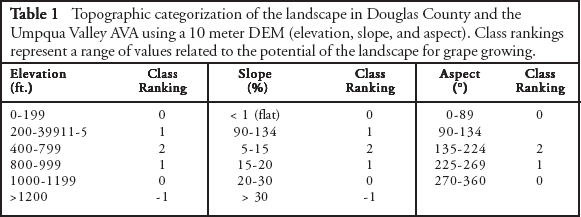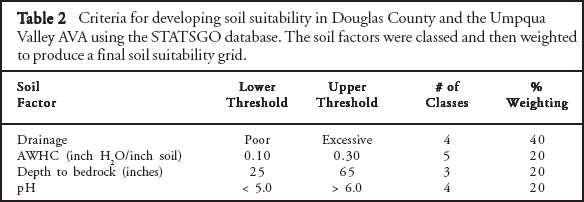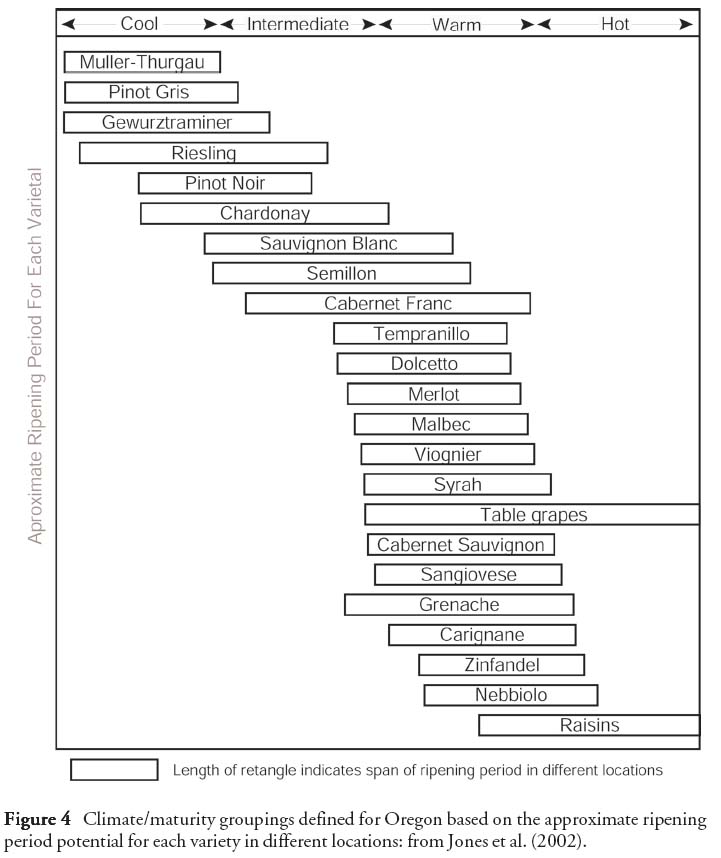Geology and Wine 8. Modeling Viticultural Landscapes: A GIS Analysis of the Terroir Potential in the Umpqua Valley of Oregon
Gregory V. JonesDepartment of Geography, Southern Oregon University, 1250 Siskiyou Blvd Ashland, Oregon 97520 U.S.A.
gjones@sou.edu
Nicholas Snead
Department of Geography, Southern Oregon University, 1250 Siskiyou Blvd Ashland, Oregon 97520 U.S.A.; Department of Planning Public Policy & Management, School of Architecture and Allied Arts, 119 Hendricks Hall, 1209 University of Oregon, Eugene, Oregon 97403-1209 U.S.A.
Peder Nelson
Environmental Education Program, Southern Oregon University, 1250 Siskiyou Blvd, Ashland, Oregon 97520 U.S.A.
Accepted as revised 8 August 2004
SUMMARY
Terroir is a holistic concept that relates to both environmental and cultural factors that together influence the grape growing to wine production continuum. The physical factors that influence the process include matching a given grape variety to its ideal climate along with optimum site characteristics of elevation, slope, aspect, and soil. While some regions have had hundreds and even thousands of years to define, develop, and understand their best terroir, newer regions typically face a trial and error stage of finding the best variety and terroir match. This research facilitates the process by modeling the climate and landscape in a relatively young grape growing region in Oregon, the Umpqua Valley appellation. The result is an inventory of land suitability that provides both existing and new growers greater insight into the best terroirs of the region.SOMMAIRE
Le terroir est un concept holiste de facteurs environnementaux et culturels agissant sur un continuum s'étendant de la croissance de la vigne à la vinification. Dans le domaine des facteurs physiques, il faut trouver la combinaison idéale entre la variété du raisin d'une part, et le climat et les caractéristiques du site de culture comme l'élévation, la pente, l'aspect et le type de sol, d'autre part. Alors qu'en certaines régions, on a eu des centaines, voire des milliers d'année pour définir, développer et définir le terroir idéal, dans les régions nouvelles, on doit procéder par essais et erreur pour trouver le meilleur appariement raisin et terroir. La recherche décrite ci-contre entend faciliter ce processus de mariage idéal en modélisant les facteurs du climat et du paysage dans une région viticole relativement jeune de l'Orégon, celle de la vallée de Umpqua. Le résultat obtenu est un inventaire des terrains propices, ce qui fait aussi bien l'affaire des vignerons établis que des nouveaux vignerons dans leur quête des meilleurs terroirs de la région.
INTRODUCTION
1 Overall, the quality of wine produced in any viticultural region comes primarily from the high quality of the grapes, which are carefully vinified through often long-held cultural practices in the winery. The quality of the grape, however, is the result of the combination of five main factors: the climate, the site or local topography, the nature of the geology and soil, the choice of the grape variety, and how they are together managed to produce the best crop (Fig. 1). The French have named this interaction between cultural practices, the local environment, and the vines, the "terroir." While there will always be some disagreement over which aspectsof the terroir are most influential, it is clear that the prudent grape grower must understand their interactions and controls on grape growth and quality (for a good review of the concept of terroir see Vaudour, 2002).
2 Numerous researchers have examined various aspects of terroir at different spatial scales providing insights into the complex inter-relationships between grape growing, quality wine production, and the site. In a comprehensive book on terroir, Wilson (1998) discusses the debate of which terroir factor is more important – nature or the winemaker's art – with the general conclusion that the debate may never be scientifically understood enough to differentiate the component contributions, but that its discourse has provided greater recognition of the influence that geology and geological processes have relative to wine quality traits. Haynes (1999) further discusses the importance of the interrelationships of all the terroir-related factors in the production of quality of wine, however the author makes a sound case of the soil and subsoil being the "determining factor controlling the taste and bouquet of a wine" by examining vineyard designation differences in the Côte d'Or region of France. Applied terroir-related research has resulted in examinations of individual elements such as soil (Becker, 1988), plant growth (Tesic et al., 2002a), viability of specific varieties (De Villars, 1997), cultural practices (Jordan et al., 1980), climate (Smart and Dry, 1980; Jackson and Cherry, 1988), and the zoning of viticultural environments (Carey, 2001; Carey et al., 2001). Others have addressed site suitability issues as a collection of factors that allow insights into a region's unknown potential (Tukey and Clore, 1972; Sayed, 1992; Boyer and Wolf, 2000;Jones, 2001) or as a measure of prediction for new areas to plant in existing regions (Davis et al., 1984; Margary et al., 1998; Tesic et al., 2002b). From a geology perspective, applied research has helped redefine sub-appellations in the Niagara Peninsula of Canada based on a combination of bedrock geology, soil, and climate, not simple climate zones as originally delineated (Haynes, 2000). In addition, two detailed studies by Meinert and Busacca (2000 and 2002) in the Walla Walla and Red Mountain appellations of Washington have yielded great insight into how, over a relatively small area, geology combines with climate to yield a broad range of wine styles and consistently high-rated wines.
Figure 1 Factors encountered in the grape growing to wine production continuum. Note that viniculture is the study or science of making wines.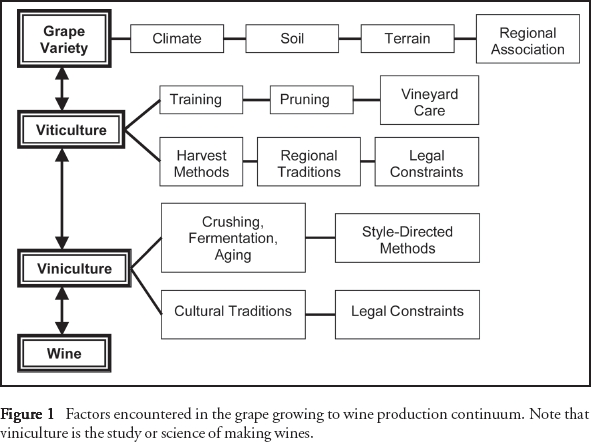
Display large image of Figure 1
Assessing the Physical Aspects of Terroir
3 Assessing a site's physical terroir aspects is arguably the single most important process that any potential grape grower will encounter when starting out (Jones and Hellman, 2003). Combined with matching the site to a grape variety, this decision will ultimately affect the vineyard's yield, the quality of the wine produced, and the vineyard's long-term profitability (Wolf, 1997). In addition, site selection normally involves compromises, in that few sites will possess ideal landscape and climate characteristics in every respect. Terroir assessment (site assessment) represents a complex suite of issues that must be factored into any plan to establish a successful vineyard operation. Numerous overviews exist that detail site selection in general (e.g., Dry and Smart, 1988; Gladstones, 1992) or for specific regions (e.g., Shaulis and Dethier, 1970; Wolf, 1997; Jones and Hellman, 2003) and focus mostly on climate, topography, and soil factors.
4 Of all site factors, climate exerts the most profound effect on the ability of a region or site to produce quality grapes. Over time the average climate structure of an area has proven to determine to a large degree the defining wine style, with variations in wine production and quality being chiefly controlled by husbandry decisions and short-term climate variability. Climate factors include solar radiation, heat accumulation, temperature extremes (including winter freezes and spring and fall frosts), precipitation during the principal growth stages, wind, and extreme weather events such as hail. Each climate factor should be assessed from the overriding macroscale down to the site or toposcale and even into the canopy (microscale).
5 The topography and soils of a site play important roles in grapevine growth and quality, and have interactive effects with climatic elements. Topographic factors that exert the greatest influence on a site's climate include elevation, slope, aspect, hill isolation and how it affects air drainage, and proximity to bodies of water. A marginal climate can be mitigated to some degree by locating the vineyard on an ideal site. From a soil standpoint, high-quality wines are made from grapes grown in many different types of soils with no single type considered ideal, however each soil imparts its own unique taste and mouth-feel to a given variety (Wilson, 1998). Grapevines will tolerate a wide range of soils, with nutrient imbalances and moisture issues being the principal factors to consider. Soil drainage is the most important physical property. Waterlogged soils will lead to a reduction in vine health and added difficulties in vineyard management. Adequate soil depth is next in importance. A minimum of 30-40 inches of permeable soil and no impeding layers (shallow bedrock, chemical or physical hardpans) is needed for optimum vine growth (Dry and Smart, 1988). Finally, soil fertility should be moderate for grapevines. Soil that is too fertile along with excessive vegetative growth can be problematic; in contrast, impoverished soils can require economically intensive applications of nutrients. Soil pH is a good indicator of the availability of nutrient cations and therefore fertility.
Grape Growing in Oregon
6 Oregon currently ranks as the fourth largest wine producer in the United States, growing grapes in six appellations (Federally designated grape growing and wine making regions, called American Viticultural Areas -AVAs): Applegate Valley, Columbia Valley, Rogue Valley, Umpqua Valley, Walla Walla Valley, and Willamette Valley (Fig. 2). In 2002 there were 582 vineyards and 176 wineries growing more than 25 different varieties on over 10,000 harvestable acres with an economic benefit of over 250 million dollars to the state (Oregon Vineyard and Winery Reports, 2002). While Oregon is widely known for its Pinot Noir, other regions in Oregon are finding that warmer climate varieties can be ripened to produce quality wines (e.g., Merlot, Tempranillo, Syrah, and Malbec).
Umpqua Valley AVA
7 The Umpqua Valley American Viticultural Area (AVA) is located entirely within Douglas County (Fig. 3) (Code of Federal Regulations, 2000). Grape growing and wine making started in the Umpqua Valley during the 1880s, but because of the region's distance to a larger market (i.e., Portland, San Francisco) it never established itself as a dominant industry in the region. In 1961 the region became the home for some of the earliest plantings of post-prohibition winegrapes in Oregon and in 1984 the Umpqua Valley AVA was established. Within the region, there is a diverse array of landscapes and climates that offer the various conditions needed to produce both cool and warm climate grape varieties. Today, the Umpqua Valley AVA has over 650,000 acres zoned for agriculture and, as of 2002, was planted with over 1,100 acres of vines on nearly 60 vineyards (Jones, 2003a). Production totaled over 1200 tons of grapes crushed at twelve wineries in 2002 (Oregon Vineyard and Winery Reports, 2002) with the dominant varieties grown being Pinot Noir, Chardonnay, Riesling, Cabernet Sauvignon, Pinot Gris, Merlot, and Gewurztraminer. Although the varieties listed above make up over 80 percent of the crop in the Umpqua Valley, the region is proving to be well suited for other varieties such as Baco Noir, Maréchal Foch, Tempranillo, Syrah, Malbec, and Dolcetto.
Figure 2 The spatial depiction of Oregon's American Viticultural Areas (AVAs). The Umpqua Valley AVA is completely contained in Douglas County.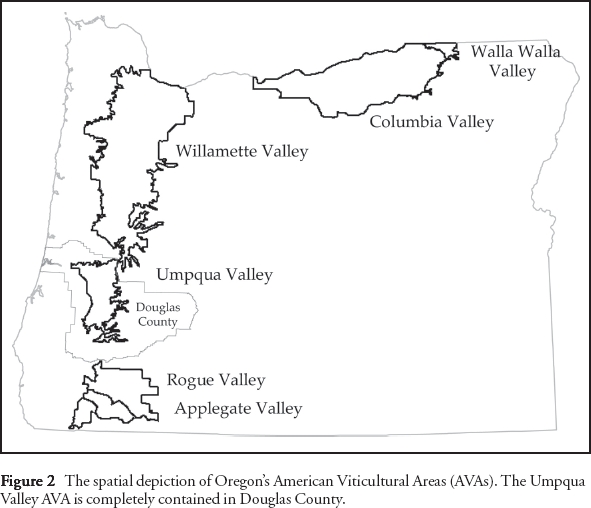
Display large image of Figure 2
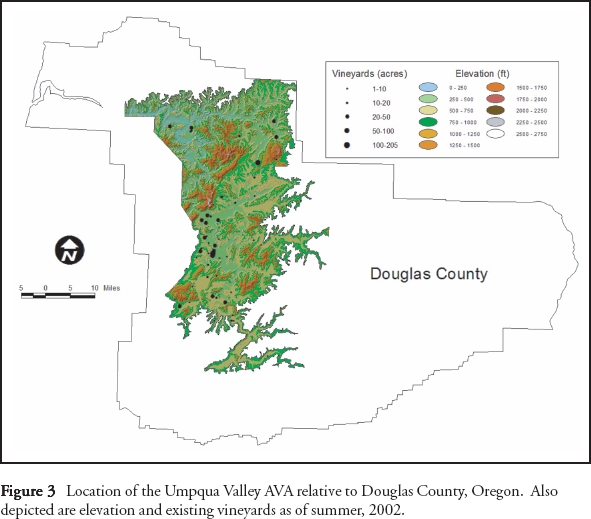
Display large image of Figure 3
8 In comparison to the other grape growing regions in Oregon, the Umpqua Valley AVA has the most beneficial climate structure in the state, with the longest growing season, the lowest risk of both spring and fall frosts, and low-ripening period rainfall and temperature extremes (Jones, 2003b). The region is warmer than the Willamette Valley to the north, but cooler than the Rogue Valley to the south (Fig. 2). Heat accumulation varies north to south in the AVA with growing degree days averaging 2200-2400 in the north and 2400-2700 in the south. Precipitation is also quite variable from north to south, averaging 30-60 inches annually (Oregon Climate Service, 2002). The growing season averages 200 days across the AVA, varying from 180 to over 215 days depending on elevation, while the median last and first frost (32°F) occurs on April 10 and October 31, respectively.
9 The topography of the region is extremely diverse, being derived from the joining of three mountain ranges of varying ages and structure: the Klamath Mountains, the Coastal Range, and the Cascades. The Klamath Mountains extend into the southwestern portion of the AVA and consist of complex folded and faulted igneous and metamorphic rocks that are the oldest in the region. The Cascade Mountains to the east consist of the younger High Cascades and the older, more deeply eroded Western Cascades that make up the eastern boundary of the AVA. The region is protected from the ocean largely by the Coastal Mountains, which are composed of mostly oceanic sedimentary rocks and volcanic islands that were accreted to the landscape over the last 50 million years. Often called the "Hundred Valleys of the Umpqua," the region is drained by the North and South Umpqua rivers, which join near the center of the AVA and empty into the Pacific Ocean. The landscape of the Umpqua Valley AVA is mostly valley lowlands with some isolated hills, stream terraces or benches, and footslopes of alluvial fans scattered by isolated hilltops and ridges. From this diverse geology comes a widely varying mix of metamorphic, sedimentary, and volcanic derived soils. The lower elevations of the valley are mostly deep alluvial material or heavy clays while the hillside and bench locations have mixed alluvial, silt, or clay structures. Complex faulting, especially in the southern part of the AVA, can produce large variations in soil types over areas the size of a vineyard. Drainage and moisture-holding capacity vary greatly by soil type, and while most soils in the region do retain water into the growing season, available water for irrigation during mid to late summer growth is generally needed. Soil fertility varies greatly over the region with issues generally related to either imbalances of nitrogen, calcium, potassium, phosphorous, magnesium, boron, or zinc. Soil pH also varies from region to region (roughly from 4.5 to 7.0) and is mostly due to differences in climate and parent rock material. In general, the soils in the northern portion of the AVA are slightly more acidic than those of the south as a result of more rainfall and greater leaching potential.
10 Even with over 40 years of post-prohibition grape growing experience, deciding to grow grapes in the Umpqua Valley can be a complex issue owing to the diverse geography and climate. For any existing and potential grape grower, vineyard site selection, or choosing the best terroir, is the single most important decision to be made. Therefore, the research described herein attempts to clarify the locational factors important to grape growing in the Umpqua Valley AVA through a multi-factor terroir-related analysis. The goal of the research is to model the best grape growing landscapes in the Umpqua Valley AVA, and to provide an inventory of sites to facilitate greater success in the grape growing to wine quality continuum.
DATA AND METHODS
11 To analyze the terroir of the Umpqua Valley, a multi-stage Geographic Information System (GIS) analysis was set up to incorporate factors related to the topography, soils, land zoning, and climate. The research started with the construction of a comprehensive GIS database of the individual vineyard sites in the Umpqua Valley AVA (Jones, 2003a). During the summer of 2002 each vineyard was surveyed using a Global Positioning System (GPS) to geographically locate the sites. Locational data from the existing vineyards, along with conversations with growers and winemakers, was then used to define the topographical and soil characteristics of the best sites for grape growing in the region.
Topographic Suitability
12 The topographic landscape was analyzed through the use of over 120 United States Geological Survey 10 meter digital elevation models (DEM). Each 1:24,000 scale quadrangle for Douglas County, Oregon was mosaiked into a complete county DEM grid (raster data). The entire landscape in Douglas County and the Umpqua Valley AVA was then categorized for the most advantageous elevations, slopes, and aspects for growing grapes. The categorization was constructed as a multilayer, topographically driven potential site analysis using ArcGIS (ESRI, 2003) with class rankings given each grid based on its potential. Elevations were categorized from 0-1200 feet into six classes (although grapes are grown at elevations greater than 1200 feet in the region, anything above that value has a much greater frost/freeze risk). Elevations from 400-799 feet were given the highest value and those greater than 1200 feet given a -1 or not viable (Table 1). Slopes were categorized into six classes from less than 1% (or basically flat with poor cold air drainage) to those over 30% being classed -1 or not viable (increasing slopes cause problems using vineyard equipment). The best slopes are considered to be those in the 5-15% range (Table 1). The aspect of the landscape was categorized into five classes with those from south-southeast to south-southwest given the highest ranking because of greater solar radiation receipt and ripening potential (Table 1). The three separate grids were then added together to produce a single topographical suitability grid with values ranging from not viable (anything with a negative score, coming from either being too high in elevation or on extremely steep slopes) to least suitable through most suitable landscapes. Owing to the spatial heterogeneity of most landscapes and realizing that potential sites need to be of adequate size to be profitable, the final grid was resampled using a nine acre neighborhood mean calculation. This size was used as smaller neighborhoods did not adequately produce homogeneous regions while larger neighborhoods created unrealistically smoothed regions.
Table 1 Topographic categorization of the landscape in Douglas County and the Umpqua Valley AVA using a 10 meter DEM (elevation, slope, and aspect). Class rankings represent a range of values related to the potential of the landscape for grape growing.
Soil Suitability
13 To analyze the Umpqua Valley AVA's soils, data were obtained from the State Soil Geographic (STATSGO) Data Base for Douglas County Area, Oregon (NRCS, 1997). Site suitability relative to soils was analyzed in a similar manner to Margary et al. (1998) for New York, using the Soils Suitability Extension (SSE) with adjustments made for soils found in Oregon (Stulz, 2001). Four soil properties were used in the categorization of suitability: drainage, depth to bedrock, available water-holding capacity, and pH.
14 Drainage is thought to be the most important soil factor in establishing and maintaining a vineyard (Cass, 1999) and is influenced by many structural issues such as texture, depth, slope, and aspect. To assess soil drainage, the STATSGO database was analyzed by individual Hydrologic Soil Groups by map unit in the database. The four groups represent variations in drainage from good to poor (groups A to D). In dry growing regions like Oregon, depth to bedrock gives an indication of how well vines can cope with dry periods, with a minimum of 30-40 inches generally needed (Jordan et al., 1980; Dry and Smart, 1988). Mean depth to bedrock was calculated using the STATSGO database from the low to high bedrock depths for each component, and a weighted average was obtained for each map unit. While drainage is extremely important in vineyards, a soil's available water-holding capacity (AWC) is important as those soils with adequate water-holding capacity are at an advantage, giving vines the greatest ability to tolerate periods of moderate drought (Cass, 1999). AWC was calculated from the STATSGO database by computing the mean value for each soil layer, summed over the layers for each component, and then weighted by the percentage of each component per map unit (Margary etal., 1998). Soil pH gives an indication of fertility and nutrient balance with most ideal vineyard soils being found between 5.5-8.0. Outside this range, nutrients may become out of balance, with deficiencies or toxic levels affecting vine uptake or beneficial relationships with microorganisms. Soil pH was computed from the STATSGO database by computing the mean value for each soil component and then weighting by the percentage of each component per map unit.
15 The spatial polygon data was then converted to grids at the same nine acre resolution to match the landscape suitability grid. Each soil factor was then grouped into classes based upon their individual values; drainage from poor to excessive, available water holding capacity from 0.10 to 0.30 inches of water per inch of soil; depth to bedrock from 25 to 65 inches; and pH from values less than 5.0 to values over 6.0 (Table 2). All classes in each grid were then scaled and weighted with drainage given the greatest weight (40%) and each of the other factors weighted 20%. A final grid of soil suitability was then constructed from the weighting of the four soil factors.
Land-Use Suitability
16 To incorporate land-use issues relative to agricultural development, a statewide generalized zoning coverage was used in the analysis (OGDC, 2003). The zoning data used was initially digitized from data collected from 1983 through 1986 by the Oregon Department of Land Conservation and Development. Since its production, limited zoning changes have occurred and the dataset represents the best statewide zoning coverage available for the state of Oregon. For this analysis only lands zoned agriculture, farm/forest transition, and rural residential are considered as viable parcels on which to develop a vineyard. The farm/forest transition zoning was included, as this type of land tends to be on slopes that are currently used by vineyards and is easily converted to new vineyard sites. The rural residential zoning is set for both two and five acre parcels and is included because many vineyards in southern Oregon can be found on sites in this zoning. The coverage was converted to a grid with all agriculture and farm/forest transition zones given a value of 2, rural residential given a value of 1, and all others a -1 representing a zoning limit to viability.
Table 2 Criteria for developing soil suitability in Douglas County and the Umpqua Valley AVA using the STATSGO database. The soil factors were classed and then weighted to produce a final soil suitability grid.
Climate Suitability
17 To assess the climate suitability of the Umpqua Valley AVA, a composite climate model was constructed based upon earlier work conducted for Oregon by Aney (1974) and Mastin (1983). These early analyses of climate suitability used available climate station data to create crude isolines of suitable areas for either cool or warm climate grape varieties. Climate factors used included winter minimum temperatures, growing season length, growing season potential evapotranspiration, heat summations, sunshine hours, and a precipitation index. To better depict the spatial variation in climate factors, this analysis uses the PRISM (Parameter-elevation Regressions on Independent Slopes Model) model, which is derived from a combination of point data, a digital elevation model, and other spatial data sets to create estimates of monthly and annual climate variables that are gridded at roughly 1.45 miles resolution (Daly et al., 2001). The composite climate model was developed for the western Oregon AVAs (Jones et al., 2002) using the most agriculturally and economically important variables.
18 Absolute climate viability was determined from extreme winter temperatures where areas that experience values lower than 5°F were deemed not viable for grape growing. The model then proceeds to build climate/maturity groupings for cool, intermediate, warm, and hot climates (Fig. 4) based initially on growing degree days (GrDDs; from April to October using a base of 50°F) using practical experience in Oregon. Each climate maturity group is classed to a 25 point range that represents a growing degree day potential within that grouping. The initial GrDD grids are then adjusted for the relative impact that each of the other climate variables has on production viability (frost-free period, last spring frost, first fall frost, rainfall frequency and amount during flowering and harvest, and ripening period temperature variability). For example, the length of the growing season, defined as the days between the first and last frost, is most advantageous when it is at least 180 days or greater (Dry and Smart, 1988). In the modeling, the frost free period was weighted as +2 if over 200 days; +1 if 180-200 days; 0 if 160-180 days; -1 if 140-160 days; and -2 if less than 140 days. The resulting grid was then added to the initial GrDD grid to adjust the grouping relative to how equitable the growing season length is to grape maturation potential. Each of the other climate variables are weighted individually, then added or subtracted to/from the initial GrDD grid. Frost timing is included by using the median last spring and first fall dates (based on 32°F) in reference to the known timing of phenological events for grape varieties grown in Oregon (Jones et al., 2002). Precipitation effects were assessed by weighting climate grids on the frequency and amount of rainfall that occurs during the critical growth stages of flowering and maturation. Finally, a ripening period temperature variability factor (extremes of both daily and monthly temperature), as defined by Gladstones (1992), was included. The temperature variability index accounts for how relatively constant, intermediate temperatures during the ripening period enhance the biochemical developmental processes of colour, flavour, and aroma that lead to high-quality wine. Grids are scored relative to a given ideal range as defined by Gladstones (1992). The final grid represents an adjusted climate/maturity value relative to the sum effects of multiple climate factors that attempt to define maturity potential by minimizing climate-related risks.
Figure 4 Climate/maturity groupings defined for Oregon based on the approximate ripening period potential for each variety in different locations: from Jones et al. (2002).Composite Suitability
19 The three site factors – topography, soil, and land-use grids – after being internally scaled relative to their individual grape-growing influences (as defined above), were then combined to produce a composite suitability grid taking into account the combined landscape/land-use effect. The composite grid was then masked with the climate maturity group grid to remove all non-climatically viable areas and then overlaid with the climate maturity group grid to produce a spatial depiction of the best vineyard sites in each maturity group in the Douglas County and Umpqua Valley AVA areas.
RESULTS
20 The Umpqua Valley AVA encompasses a total of 689,154 acres in Douglas County, Oregon (Fig. 3). The GPS survey identified 58 vineyards geographically dispersed from north to south over the AVA, with the greatest concentration in the west-central portion of the AVA (Fig. 3). Overall, the 58 vineyards consist of a total of 1,106 acres and range from one acre or less to 205 acres, with a median vineyard size of 9.3 acres. Vineyards are planted at elevations ranging from 197-1296 ft., with an average elevation of 581 ft. and a majority found at between 400 and 800 ft. Vineyard slopes in the region range from flat to over 50%, averaging 8.3% with a standard deviation of 6.4%. Aspects vary over all cardinal directions with south-southeast to west most common, and an average of south-southwest.
21 The information derived from the GPS survey, along with a general understanding of the ideal topographic characteristics (Table 1), resulted in a grid depicting those landscapes most topographically suited to grape growing in the region (Fig. 5). The vast majority of the county is considered not suitable (60.8%) or least suitable (15.2%) for grape growing, owing to a combination of elevation, slope, and aspect that represents unsuitable landscapes (Table 3). Although the suitability grid reveals that no ideal landscapes (as scoring the highest on all three factors combined) exist in the region, a summation of all intermediate to most suitable landscapes identifies over 218,000 acres in Douglas County. At the appellation level, the Umpqua AVA contains the vast majority of the region's intermediate to most suitable landscapes (88%), with the difference being the area in the northwest of the AVA where good sloping land can be found, but at lower elevations (Fig. 5). Using the highest topographic suitability class, nearly 13,000 acres can be found within the Umpqua Valley AVA (Table 3).
Table 3 Topographic suitability acreage as derived from the combined elevation, slope, and aspect grids used in the analysis. Values given for both Douglas County and the Umpqua Valley AVA.
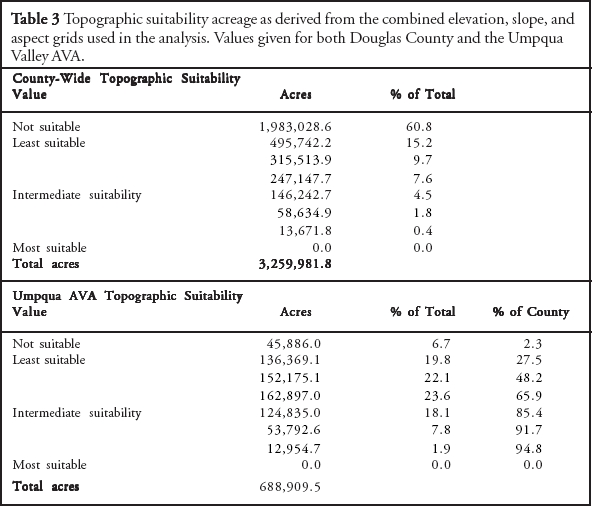
Display large image of Table 3
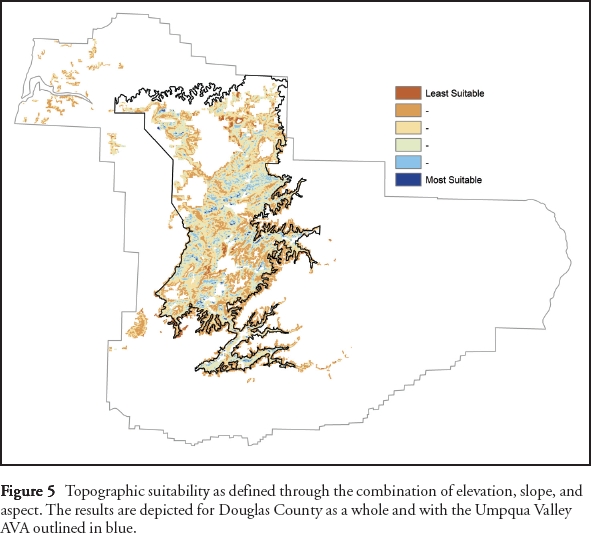
Display large image of Figure 5
22 The soil analysis resulted in four individual grids that depict drainage, depth to bedrock, available water-holding capacity, and pH variations for individual map units for Douglas County (not shown individually). Spatial variations in hydrological groups indicate that the best drained soils are found near the coast, in sandy soils and along the alluvium-filled valleys and terraces of the Umpqua River. Poor drainage areas are most notable in the lands underlain by older metamorphic rocks of the Klamath Mountains to the south. Similar patterns are found with depth to bedrock, with the deepest soils found near the coast, in broad areas surrounding the main river drainages, in upland regions in the volcanic soils of the Cascades, and in isolated areas throughout the county. Depth to bedrock averages 44 inches over the county, with a minimum of just less than 20 inches and a maximum of just over 60 inches. Available water-holding capacity (AWC) varies from the coast, where higher values can be found in the more silty to clay-rich soils, to lower values in the soils of the Klamath Mountains and some of the more excessively drained soils in the area. AWC averages 0.15 inch of water per inch of soil in the county, with a minimum of under 0.01 to a maximum of just over 0.30 inches. Soil pH in Douglas County ranges from 4.7 to 6.6 with a mean of 5.6. Spatial variations are seen in the more acidic coastal soils, coastal mountains, and in much of the Cascades. More neutral pH soils are found along the main reaches of the middle portions of the South Umpqua River and throughout the Klamath Mountains.
23 The combined weighted soils-suitability categorization results in a single grid that depicts the best soils for grape growing with moderate to well drained soils, adequate depths to bedrock, moderate to good water-holding capacity, and more neutral soil pH (Fig. 6). The most suitable soils, those scoring more than the mean composite grid value, are found along the coastal zone, in a broad upland area in the northwestern portion of the county, along the main reaches of the middle portions of the North and South Umpqua Rivers, and along a broad upland region stretching from the southwest portion of the county into the western Cascades.
24 Land use in Douglas County is dominated by rural-designated zoning types where over 77% of the land is zoned for forestry, 19% is zoned for agriculture, and 2% for rural residential zoning categories (Fig. 7). For land zoned agriculture, the designations are further divided into three broad categories: agriculture (40%), farm/ forest transition (56%), and rural residential (4%). In the Umpqua AVA, 67% of the land area is zoned agriculture with roughly equal amounts of exclusive agriculture and farm/forest transition (44% and 49%, respectively) along with 7% zoned rural residential.
25 Combining the topographic, soil, and land-use grids produced a point scale of suitability from which viable vineyard sites in Douglas County and the Umpqua Valley AVA are mapped (Fig. 8). Suitability scores range from a low of 26 to a maximum of 100, with an average of 62.1 and a 20.9 standard deviation. Using the unsuitable criteria in the topographic grid (too high in elevation or too steep slopes), along with the lands that are not zoned appropriately (other than agriculture or rural residential), reduces the suitable areas to lands mostly within the AVA (82%). Some suitable areas are found outside the AVA near the coast along the Umpqua River, in scattered valleys west and southwest of the AVA boundary, and along many of the stream reaches just outside the AVA boundary. Examining only those areas that scored greater than 1.5 standard deviations above the mean finds that there are nearly 3000 acres of the best sites clustered throughout the AVA boundary.
Figure 6 Soil suitability as defined through the combination of drainage, depth to bedrock, available water-holding capacity, and pH. The results are depicted for Douglas County as a whole and with the Umpqua Valley AVA outlined in blue.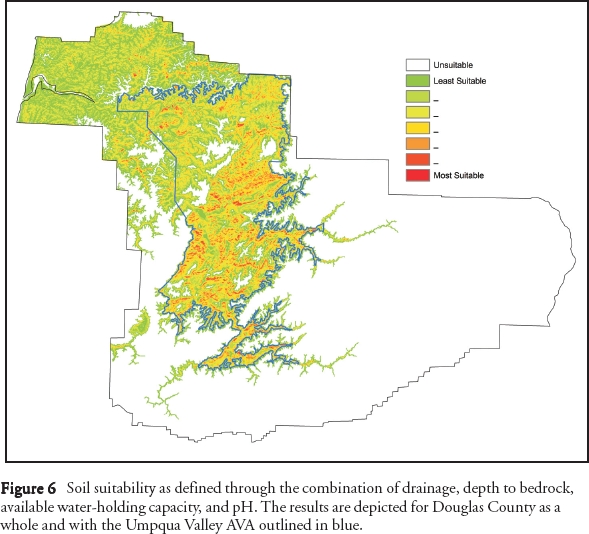
Display large image of Figure 6
26 The climate maturity analysis produced a grid that spatially represents the potential for the region to ripen given varieties as depicted in Figure 4. The resulting map depicts the region as one that is largely viable with respect to its grape-growing climate (Fig. 9), with the majority of the landscape being classified as a cool climate maturity group (52%). The intermediate climate maturity group area (19%) is found mostly in the intermountain valleys of the Umpqua River drainage. The warm climate maturity group makes up the smallest area at 0.5% or roughly 5,300 acres. There are no areas deemed suitable to the hot climate maturity grouping in the AVA. Examining the climate suitability inside the Umpqua Valley AVA finds that the area is largely an intermediate (60%) and cool (38%) climate maturity region with less than 2% of the area deemed climatically not-viable (Fig. 9).
27 The combined topographic, soil, and land-use suitability grid was then masked with the climate maturity group grid's not viable area to further reduce the suitability to only those landscapes that can adequately ripen fruit across any of the climate maturity groups. The composite suitability grid is then depicted using the individual climate maturity groupings to show the spatial variation of terroir potential in the AVA (Fig. 10). Areas of non-suitable land are generally being limited through one of four main factors: elevation, slope, urban- or forest-zoned lands, or climate (shown in white in Fig. 10). Those lands deemed suitable that fall outside the AVA boundary include mostly cool climate groups with a few intermediate climate groups and can be found near the coast, to the west and southwest of the AVA in isolated valleys, and extending up some of the river valleys throughout the region. Cool-climate suitable land is found throughout the region with the greatest concentrations along the eastern, southern, and western AVA boundary area as elevations increase, and in a broad area in the northern portion of the AVA. Intermediate-climate suitable land is found covering much of the AVA, extending from the southern valleys, throughout the broader central portion of the AVA, and into a small area to the north (Fig. 10). Warm-climate suitable land is confined to an area in the west-central portion of the AVA. Examining only those landscapes that scored greater than 1.5 standard deviations above the mean landscape suitability results in 300, 2600, and 35 acres of the most suitable lands found in the cool, intermediate, and warm climate regions, respectively.
Figure 7 Land-use suitability as defined by all lands zoned either agriculture or rural residential. The results are depicted for Douglas County as a whole and with the Umpqua Valley AVA outlined in blue.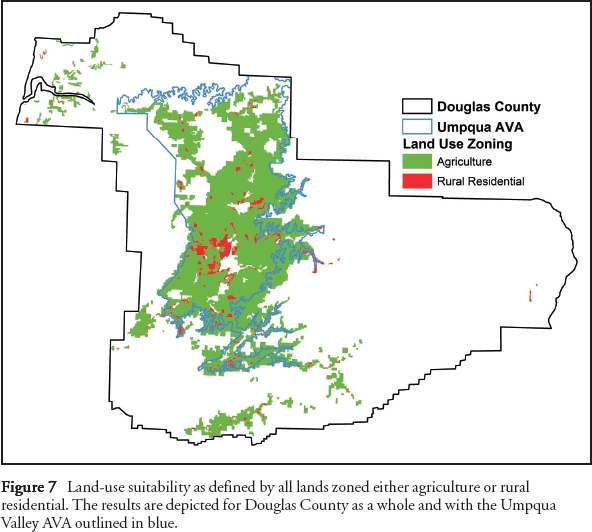
Display large image of Figure 7
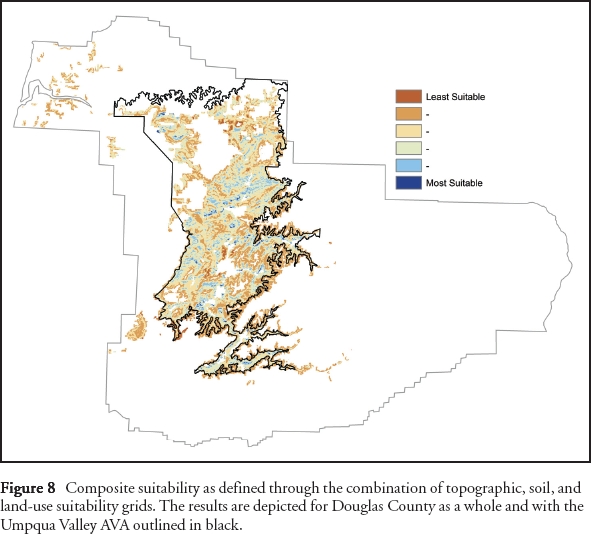
Display large image of Figure 8
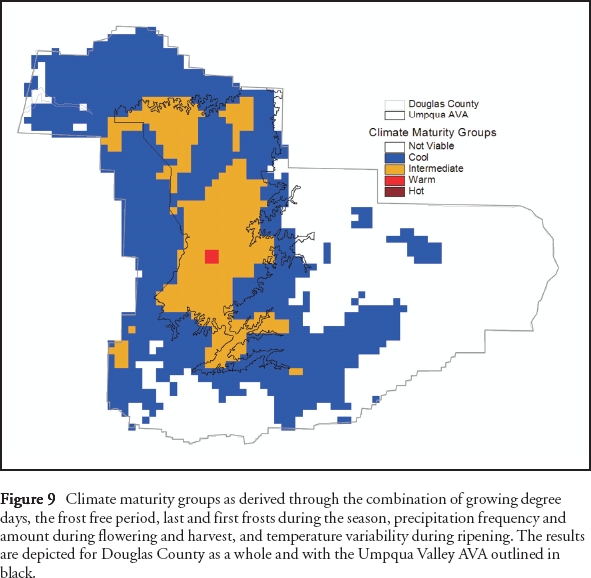
Display large image of Figure 9
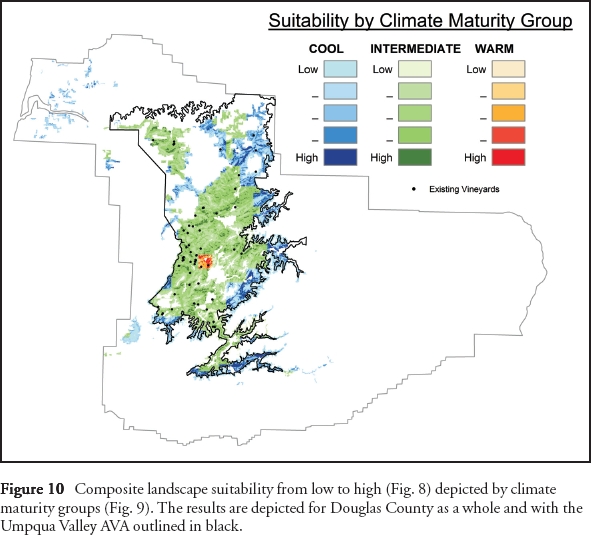
Display large image of Figure 10
28 Since the original suitability criteria were established from a baseline of the existing vineyards, a comparison of the various suitability factors with the existing vineyards reveals how well they are situated in terms of the modeled terroir. From a topographic standpoint (elevation, slope, and aspect), the existing vineyards rank generally in the 5th and 6th deciles of topographic suitability (a decile divides a distribution of ranked scores into equal intervals where each interval contains one-tenth of the scores) with only six vineyards ranking in the 8th decile or higher (no existing vineyards are found in the topographically not viable regions). The main limiting factor related to topography that affects the existing vineyards is being planted to a flat site. Compared to the derived soil suitability (Fig. 6), the existing vineyards are found to be located on soils in the 6th and 7th deciles of the combine drainage, AWC, depth to bedrock, and ph suitability. Examining the relationship between the composite landscape suitability and climate maturity groups finds that 7, 49, and 2 of the existing vineyards are found in the cool, intermediate, and warm climate areas, respectively (Fig. 10). For the climate groupings, the seven vineyards in the cool region are mostly in the 6th and 7th decile of landscape suitability, the 49 vineyards in the intermediate region are in the 7th and 8th decile of the landscape suitability, and the two vineyards in the warm climate region are in the 6th decile of the landscape suitability. Potentially more important is that the existing vineyards represent only 24%, 13%, and 6% of the most suitable acreage that scored greater than 1.5 standard deviations above the mean landscape suitability in the model.
CONCLUSIONS
29 This research attempted to define and map terroir potential by examining the grape-growing landscape in the Umpqua Valley AVA of Oregon through the spatial analysis of topography, soil, land use, and climate. Using a locational survey of existing vineyards and grower knowledge of the best landscapes for grape growing, the topography of the region was classed into the most suitable elevations, slopes, and aspects for vineyards. The combined topographic suitability analysis shows that much of the area in the AVA, and some areas outside the AVA, provide fair to very good landscapes for grape growing. An assessment of soil suitability finds spatial variations in drainage, depth to bedrock, available water-holding capacity, and pH that are related to the underlying geology. The most advantageous soils with moderate to good drainage, adequate soil depths, fair to good water-holding capacity, and near neutral pH are found in a broad belt of the Umpqua Valley AVA, along the coastal zone, and in isolated areas throughout the county. Douglas County and the Umpqua Valley AVA have a large percentage of land zoned for agriculture, farm/forest transition, or rural residential that is more easily developed into vineyard sites.
30 Combining data on topography, soil, and land use reveals that the lands most suitable for vineyard development are located mostly within the Umpqua Valley AVA, with over 3000 acres of nearly ideal sites found spread throughout the region. Masking this composite suitability with the "not-viable" climate maturity regions reduces some of the locations both inside and outside the AVA. Overlaying climate and landscape factors results in a collection of suitable sites depicted by each of the cool, intermediate, and warm climate maturity groupings. Furthermore, since a good site can mitigate a marginal climate to some degree, and since the climate maturity groups are scored relative to a ripening potential with locations falling into a range of values for a climate maturity group, the best landscapes can increase the viability of ripening a given variety. For example, a site that scores at the high end of the intermediate climate maturity group and scores high on the landscape suitability, could potentially ripen warm climate maturity group varieties (i.e., Merlot could be ripened more consistently than on a marginal landscape in an intermediate climate). Comparing the terroir modeling to the existing vineyards finds that most vineyards in the region are sited on landscapes greater than average (6th– 8th deciles of suitability) in terms of topography and soil. In addition, much of the best landscapes in each climate maturity grouping identified in the modeling (those greater than 1.5 standard deviations above the mean suitability) are not currently planted to vineyards. The results indicate that very good landscapes exist across all climate maturity types with strong potential for future development and production of quality fruit and wines.
31 While the results from this analysis are applied to a collection of land units (grids) that have varying levels of grape-growing suitability, many land units may not be available for vineyard development owing to various existing factors (e.g., already developed for other uses, not for sale, changes in zoning,etc.). Furthermore, the resulting grids do not depict availability of water for irrigation, which should be examinedon a site-by-site basis. The results presented here are also subject to spatial variations that cannot be depicted from the resolution of the original digitaldata. For example, the climate grids have a resolution of roughly 1.45 miles, which from the toposcale to the microscale may not accurately model the climate structure when the landscape constricts to areas less than this resolution. In addition, spatial differences in soil types and properties at the site level can vary substantially and should be assessed through on-site soil analyses. Finally, the generalization of the topographic suitability to a homogeneous nine acre size will produce a potential vineyard site that can have small, less than ideal landscape features within it (e.g., swales, lowspots, etc.) and should be analyzed on a site-by-site basis to define the vineyard size, shape, and block structure.
32 During its brief history, the Umpqua Valley AVA has proven to be a region in which cool- to warm-climate grape varieties can be grown. Rapid growth of the industry is likely to continue as a result of current successes and the availability of land. Through the use of GPS and GIS technologies, this research has helped to further define the terroir potential of grape growing in the Umpqua Valley AVA. The results provide existing and future growers with baseline knowledge of the region's grape-growing potential relative to its topography, soil, land use, and climate. While not specifically addressing the cultural aspects of terroir (e.g., style-directed viticultural and enological practices), which typically take many years to become dominant, the results presented here should serve to initiate better decisions in the site selection process, thus leading to fewer and/or more efficient trial and error procedures. In addition, for most potential growers, site selection will involve compromises, in that few sites will possess ideal characteristics in every respect. While compromise in many cases has been the rule, this body of research presents one of the best tools yet to enhance the site selection process for future growers in the Umpqua Valley AVA. Finally, the process developed here theoretically can be applied to any area where adequate spatial data resources are available.
ACKNOWLEDGEMENTS
This research is a compilation of various ongoing research projects that were funded by numerous sources: The Oregon Wine Advisory Board, the Umpqua Chapter of the Oregon Winegrowers' Association, and the Carpenter Foundation at Southern Oregon University. The authors would like to extend their appreciation to all of the grape growers in the Umpqua Valley AVA and H. Earl Jones for his insights into the industry.REFERENCES
Aney, W.W., 1974, Oregon Climates Exhibiting Adaptation Potential for Vinifera: American Journal of Enology and Viticulture, v. 25, no. 4, p. 212-216.
Becker, H., 1988, Mapping of soils and climate in the Rheingau: Proceedings of the Second Cool Climate Viticulture and Oenology symposium, Auckland, New Zealand.
Boyer, J. and Wolf, T., 2000, GIS and GPS aid the exploration of viticultural potential in Virginia: Vineyard and Winery Management, Nov/Dec 2000, p. 48-54.
Carey, V.A., 2001, Spatial characterisation of natural terroir units for viticulture in the Bottelaryberg-Simonsberg-Helderberg winegrowing area: M.Sc. Agriculture Thesis, University of Stellenbosch, South Africa.
Carey, V.A., Bonnardot, V., Schmidt, A. and Theron, J., 2001, The interaction between vintage, vineyard site (mesoclimate) and wine aroma of Vitis vinifera L. cvs. Sauvignon blanc, Chardonnay and Cabernet Sauvignon in the Stellenbosch-Klein Drakenstein wine growing area, South Africa (1996-2000): in Proceedings of the 26th World Congress & 81st General Assembly of the OIV, Section 1, p. 139-152.
Cass, A., 1999, What soil factors really determine water availability to vine?: The Australian Grapegrower and Winemaker, Annual Technical Issue, p. 95-97.
Code of Federal Regulations: Alcohol, Tobacco Products, and Firearms, 2000, (Title 27, Parts 1-199), Part 9 – American Viticultural Areas, p. 101-223.
Daly, C., Taylor, G.H., Gibson, W.P., Parzybok, T.W., Johnson, G.L. and Pasteris, P., 2001, High quality spatial climate data sets for the United States and beyond: Transactions of the American Society of Agricultural Engineers, v. 43, p. 1957-1962.
Davis, R., Chilton, R., Ottenbreit, L., Scheeler, M., Vielvoye, J., Williams, R. and Wittneben, U., 1984, Atlas of suitable grape growing locations in the Okanagan and Similkameen valleys of British Columbia: Agriculture Canada.
Department of Land Conservation andDevelopment, 2002, Generalized Zoning Coverage for the State of Oregon: http://www.lcd.state.or.us/
De Villiers F. S., 1997, The use of Geographic Information System (GIS) in the selection of wine cultivars for specific areas by using temperature climatic models: in Proceedings, XXII Congrès de la Vigne et du Vin, December, 1997, Buenos Aires, Argentina.
Dry, P.R. and Smart, R.E., 1988, Vineyard site selection: in Coombe, B.G. and Dry, P.R. (eds.), Viticulture; Winetitles, Adelaide, Australia.
Environmental Systems Research Institute, Inc. (ESRI). Copyright © 1995-2003. All rights reserved. Published in the United States of America.
Gladstones, J., 1992, Viticulture and Environment: Winetitles, Adelaide, Australia. 310 p.
Haynes, S.J., 1999, Geology and Wine 1. Concept of terroir and the role of geology: Geoscience Canada, v. 26, p. 190-194.
Haynes, S.J., 2000, Geology and Wine 2. A geological foundation for terroirs and potential sub-appellations of Niagara Peninsula wines, Ontario, Canada: Geoscience Canada, v. 27, p. 67-87.
Jackson, D.I. and Cherry, N.J., 1988, Prediction of a district's grape-ripening capacity using a latitude-temperature index: American Journal of Enology and Viticulture, v. 39, n.1, p. 19-28.
Jones, G.V., 2001, Using GIS/GPS Technology to Assess Viticultural Status and Potential in the Rogue Valley AVA: Proceedings of the 115th Annual Meeting of the Oregon Horticultural Society, Portland, Oregon, p. 215-227.
Jones, G.V., Hille, P., Pine, J. and Jones, H.E., 2002, Mapping Varietal Potential for Quality Wines in Oregon using PRISM Spatial Climate Data: American Meteorological Society, 13th Conference on Applied Climatology, Portland, Oregon, May 2002 (in preparation, winter, 2004).
Jones, G.V., 2003, Trends in Frost Occurrence and the Frost-Free Growing Season Length in Oregon Grape-Growing Regions: Proceedings of the 117th Annual Meeting of the Oregon Horticultural Society, Portland, Oregon, p 223-231.
Jones, G.V. and Hellman, E., 2003, Site Assessment: in Hellman, E. (ed.), Oregon Viticulture: 5th Edition, Oregon State University Press, Corvallis, Oregon, p 44-50.
Jones, G.V. and Hellman, E., 2003, Oregon Winegrowing Regions: in Hellman, E. (ed.), Oregon Viticulture: 5th Edition, Oregon State University Press, Corvallis, Oregon, p 51-69.
Jordan, T.D., Pool, R.M., Zabadal, T.J. and Tompkins, J.P., 1980, Cultural practices for commercial vineyards: New York State College of Agriculture and Life Sciences, Miscellaneous Bulletin 111, 69 p.
Magarey, R.D., Seem, R. C. and DeGloria, S.D., 1998, Prediction of vineyard site suitability: Grape Research News, v. 9, no. 1, p. 1, 2.
Mastin, M. C., 1983, Site Selection of Vineyards in Oregon: Master's Thesis, Department of Geography, University of Oregon, June, 1983, 274 p.
Meinert, L.D. and Busacca, A.J., 2000, Geology and Wine 3. Terroirs of the Walla Walla Valley appellation, southeastern Washington State, USA: Geoscience Canada, v. 27, n. 4,p. 149-171.
Meinert, L.D. and Busacca, A.J., 2002, Geology and Wine 6. Terroir of the Red Mountain Appellation, Central Washington State, USA: Geoscience Canada, v. 29, n. 4, p. 149-168.
Natural Resources Conservation Service, 1997, State Soil Geographic (STATSGO) Data Base for Douglas County Area, Oregon: http://www.ftw.nrcs.usda.gov/ssur_data.html
Oregon Climate Service (OCS), 2002, Office of the State Climatologist, Oregon State University, Corvallis, Oregon: http://www.ocs.orst.edu/
Oregon Geospatial Data Clearinghouse (OGDC), 2003, Spatial Data Library – Generalized Zoning Coverage for the State of Oregon: Department of Administrative Services, State of Oregon: http://www.sscgis.state.or.us
Oregon Vineyard and Winery Reports (1987-2002), Oregon Agricultural Statistics Service, Salem, Oregon: http://www.oda.state.or.us/oass/vinewine.htm
Sayed, H.A., 1992, Vineyard site suitability in Ontario: Ontario Grape and Wine Adjustment Program, OMAFRA and Agriculture Canada Publication N.10.92, Ministry of Agriculture and Food, Agriculture Canada.
Shaulis, N. and Dethier, B., 1970, New York site selection for wine grapes: New York State Horticultural Society, Proceedings, v. 115, p. 288-294.
Smart, R. E. and Dry, P.R., 1980, A climatic classification for Australian viticultural regions: Australian Grapegrower and Winemaker, v. 17, p. 8-16.
Stulz, M. B., 2001, The Soils Suitability Extension (SSE): National Science and Technology Center, Resource Notes, no. 49, 4/18/01.
Tesic, D., Woolley, D.J., Hewett, E.W. and Martin, D.J., 2002a, Environmental effect on cv Cabernet Sauvignon (Vitis Vinifera L.) grown in Hawkes Bay, New Zealand, 1. Phenology and characterization of viticultural environments: Australian Journal of Grape and Wine Research, v. 8, p. 15-26.
Tesic, D., Woolley, D.J., Hewett, E.W. and Martin, D.J., 2002b, Environmental effect on cv Cabernet Sauvignon (Vitis Vinifera L.) grown in Hawkes Bay, New Zealand, 2. Development of a site index: Australian Journal of Grape and Wine Research, v. 8,p. 27-35.
Tukey, R.B., and Clore, W.J., 1972, Grapes -their characteristics and suitability for production in Washington: EB. 635, Cooperative Extension Service College of Agriculture, Washington State University, Pullman, Washington, 12 p.
United States Geological Survey (USGS), 2001, 1:24,000 Scale Digital Elevation Models (DEM): http://edcwww.cr.usgs.gov/doc/edchome/ndcdb/ndcdb.html
Vaudour, E., 2002, The quality of grapes and wine in relation to geography: Notions of terroir at various scales: Journal of Wine Research, v. 13, no. 2, p. 117-141.
Wilson, J.E., 1998, Terroir: the Role of Geology, Climate, and Culture in the Making of French Wines: Mitchell Beazley, London, UK, 336 p.
Wolf, T.K., 1997, Site Selection for Commercial Vineyards: Virginia Agricultural Experiment Station, Winchester, Virginia, Publication no. 463-016.
